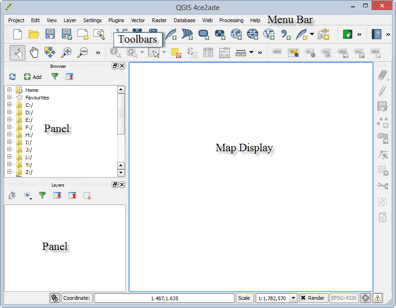This section of the free chapter preview of Mastering QGIS covers the graphical user interface components of both QGIS Desktop and QGIS Browser. Mastering QGIS is designed to bring users who want to go beyond the basics of QGIS to an advanced level of QGIS expertise.
QGIS is composed of two programs: QGIS Desktop and QGIS Browser. Desktop is used for managing, displaying, analyzing, and styling data. Browser is used to manage and preview data. This section will give a brief tour of the graphical user interface components of both QGIS Desktop and QGIS Browser.
QGIS Desktop
The QGIS interface is separated into four interface types: menu bar, toolbars, panels, and map display. The following screenshot shows QGIS Desktop with all four interface types displayed.

The map display shows the styled data added to the QGIS project, and by default, takes up the majority of the space in QGIS Desktop. The menu bar, displayed across the top, provides access to the majority of QGIS Desktop’s functionality. The toolbars provide quick access to QGIS Desktop functionality. Toolbars can be arranged to either float independently or dock along the top, bottom, left, or right sides of the application. Panels, such as Browser, and Layers, provide a variety of functionality and can be arranged to either float independently or dock above, below, right, or left of the map display.
There are four toolbars that are particularly useful and are recommended that you enable:
- The File toolbar provides quick access to creating, opening, saving QGIS projects, and creating and managing print composers.
- The Manage Layers toolbar contains tools to add vector, raster, database, web service, text layers, or create new layers.
- The Map Navigation toolbar contains tools useful for panning, zooming, and refreshing the map display.
- The Attributes toolbar provides access to information, selection, field calculator, measuring, bookmarking, and annotation tools.
QGIS Desktop offers a number of customization options. You can toggle the visibility of toolbars by clicking View | Toolbars, or by right-clicking the menu bar or enabled toolbar button, which will open a context menu allowing you to toggle toolbar and panel visibility. You can assign shortcut keys to operations by clicking Settings | Configure shortcuts. You can also change application options, such as interface language and rendering options by clicking Settings | Options.
QGIS Browser
The QGIS Browser (shown in screenshot below) interface is composed of three parts: toolbar, data tree view, and information panel.

The data tree view is an expandable tree listing of all geospatial data files on your computer and through connections. The information display, taking the majority of the space on the application, contains four tabs that provide different views of the selected data in the data tree listing:
- The Param tab displays details of data that are accessed through connections, such as a database or WMS.
- The Metadata tab displays the metadata (if any) of the selected data.
- The Preview tab renders the selected data. You can zoom in to the data using your mouse wheel and pan using the arrow keys on your keyboard.
- The Attribute tab displays the attribute table associated with the selected data. You can sort the columns by clicking on the column headings.
The toolbar provides access to four functions. The Refresh function reloads the data tree view whilst the Manage WMS function opens the WMS management screen allowing you to manage WMS connections. The New Shapefile function opens the new vector layer dialog allowing new shapefiles to be created. Finally, the Set layer CRS function allows you to define the coordinate reference system of the geospatial data file selected in the data tree view.
<– Previous: QGIS Download and Installation ~ From Mastering QGIS ~ Next: Loading Data in QGIS –>
